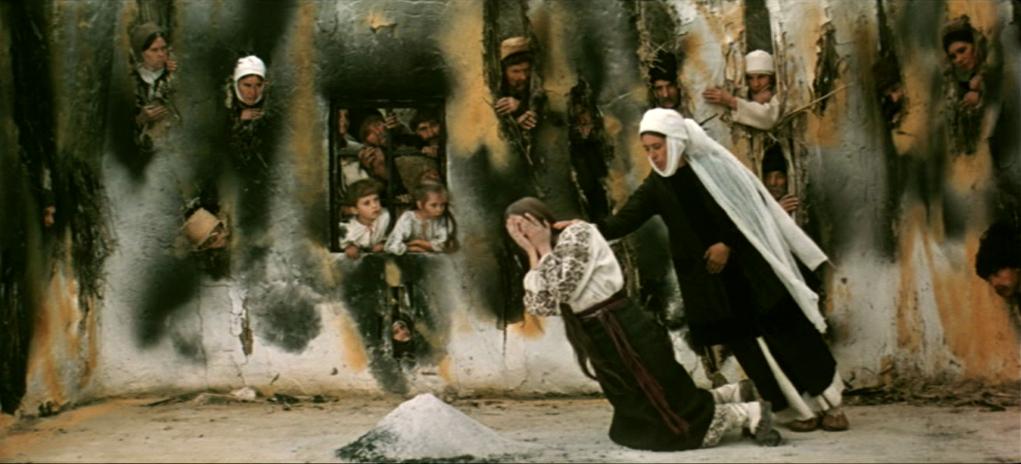
Folklorne apstrakcije, poetsko-magijske ikone krvare čudesnim slikama.
Vjerojatno najznačajniji ukrajinski režiser 20. stoljeća.
Vechir Na Ivana Kupala:
Cijeli film (s francuskim titlovima):
The Eve of St. John
Vechir Na Ivana Kupala | Yuri Illienko, 1968
USSR | 71 minutes
Spring for the Thirsty
Krynytsia Dlia Sprahlykh | Yuri Illienko, 1965
USSR | 90 minutes
White Bird With a Black Mark
Bilyi Ptakh Z Chornoiu Oznakoiu | Yuri Illienko, 1971
USSR | 100 minutes
Prayer for Mazepa Returns
| |||
Yuri Illienko’s much criticized, maligned, and even ridiculed film Prayer for Hetman Mazepa (2002) is about to get a new lease on life. After seven years of oblivion the last film of the internationally recognized director has been re-edited, supplied with a new Surround 5.1 soundtrack and in a matter of weeks will be all but ready for a theatrical release in HD Video format. The news was broken to the Ukrainian Film Club of Columbia University by Yuri Illienko himself.
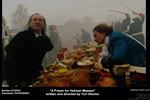
Prayer was conceived as a Ukrainian answer to Braveheart by Mel Gibson and Polish blockbuster With Fire and Sword (1999) by Jerzy Hoffman. The project enjoyed a massive financial support of the then Ukraine’s prime minister Viktor Yushchenko and had the budget of $2.5 mln., the biggest for a film since independence. The historical drama, featuring some of the best actors Ukraine boasts, was widely expected to herald a much overdue revival of the Ukrainian national cinema. Instead Prayer proved a huge box-office failure and artistic disappointment.
David Stratton of the influential industry publication Variety described it as “a willfully chaotic picture … [whose] merits, such as they are, lie in its very craziness, certainly not in its utterly confusing way of telling a story…” One intriguing aspect of the picture seemed to be an anathema vocalized in person by the Russian minister of culture Mr. Shvydkoy which meant a de facto ban on its screening in the Russian Federation and made it into something of a forbidden fruit.
Yuri Illienko explained the poor reception of his film among critics and the viewers alike by the fact that it was never finished. After a short theatrical release and screenings at several film festivals including the Berlinale (outside the competition) the Prayer vanished from view for seven years and was nowhere to be seen or purchased, not even from all-having DVD pirates. It became something of a cinematographic enigma.
This year the copyright ownership for the Prayer was transferred from the original producer Yuri Didkovsky to the Illienko Films LLC created with the express goal to complete the making of this film and to bring it to Ukrainian and international viewer. According to Mr. Philip Illienko, Yuri Illienko’s son and a co-founder of the company, the new version of the Prayer is “in fact a completed old film that up until now was not finished in what concerns its sound.” It is about fifteen minutes shorter. “The shortening of the film did not change its creative concept and artistic execution. In addition, the director’s background commentary was added with explanation of the historical context in which the events portrayed in the film unfold, as well as the history of the making of the film. This addition of author’s voice outside the frame as a protagonist of the story is organically linked to the appearance in the frame of the director himself as well as with the sometimes subjective camera movements which all the time takes part in the construction of the mise en scène as a participant rather than a mere “reporter.” In the opinion the director this new addition will facilitate the viewers’ comprehension. The Illienko Films LLC is currently looking for partners and investors to effect the Prayer’s release in movie theaters and on DVD as well as its screening on television.
The Ukrainian Film Club of Columbia university is currently exploring the possibilities of screening the new version of Yuri Illienko’s Prayer for Hetman Mazepa in New York City and other US venues. - www.columbia.edu
The following is an article I originally wrote in 1989, or maybe 1988, after seeing three films by Ukrainian poetic cinema master Yuri Illienko (a.k.a. Iurii/Yurij/Jurij Ilyenko/Ilienko/Illyenko/Il’yenko). Two of the films — A Well for the Thirsty and Eve of Kupalo Night, or St. John’s Eve — had languished unseen under Soviet censorship for some twenty years. They are screening this coming week at New York’s Lincoln Center.
Please keep in mind that I was a young Master’s student at the time I wrote this piece. The analysis could use much more historical contextualization, especially to Gogol (in the case of Eve of Kupalo) and to the film classics of Aleksandr Dovzhenko — the references to the latter are too numerous to ignore. But the descriptions should be useful for those who might have difficulty keeping up with the cultural references (or the subtitles).
The Persistence of (National) Memory: Sources and Reverberations in Illienko’s Well of Images
Adrian Ivakhiv
This article originally appeared as “The Persistence of (National) Memory: Deep Sources and Social Echoes in the Well of Illienko’s Cinema,” in Terminus v. 4 (1989), pp. 43-51.

The image of the well is central to Yuri Illienko’s 1965 film Well for the Thirsty (Krynytsia dlia Sprahlykh), and is an apt metaphor for all of his imagistic cinema. Illienko’s well is that of memory – not the dead skeleton of custom and habit, but a deeply-rooted fountainspring of collective memory and identity. Illienko’s films are heavily doused in folklore and drenched in an allegoric and poetic allusiveness rendered particularly vibrant by his dexterous cinematography. Like the fertile, underground reservoir of living water, his films maintain a silent persistence even if forgotten and hidden away, shelved until the next political thaw allows their re-emergence.
So it was that in 1987, two of his films emerged, “rediscovered,” from the shelves where their few remaining copies had been stacked away since the late 1960s: A Well for the Thirsty, from 1965, and Eve of Ivan Kupalo, from 1968. The cultural renaissance that sprang out of the post-Khrushchev “Thaw” in the Soviet republics had announced itself in cinema in Sergei Paradzhanov’s exuberant 1964 production, Shadows of Forgotten Ancestors, for which Illienko served as Director of Photography (though his role in the making of the film has been underestimated all these years). Shadows broke open the territory that was to be called the “Poetic Cinema.” It signaled not only the revival of a cinematic tradition that had disappeared in the early 1930s with the slow artistic strangulation by Stalin of Alexander Dovzhenko and others like him. It also heralded a new era of ethnographically luxurious, technically adventurous, energetic and creative filmmaking.[1]
The lid, unfortunately, was not kept open for long: A Well for the Thirsty was banned at around the same time as the first wave of arrests swept Ukraine’s intellectual circles in 1965, though the activities of the latter group were to continue until the final repressions that accompanied the removal of Ukrainian Communist Party First Secretary, Petro Shelest, in 1972.
With the release of these two films, Illienko’s leading role in the Ukrainian cinema of the past quarter-century becomes much clearer. His films rank among the best expressions of a nationally-rooted, non-realist cinema, a form that includes in its ranks the work of many of the best known directors from Latin America and the Third World, not to mention Tarkovsky, Luis Bunuel, and others. The trilogy of films, beginning with the long-banned Well for the Thirsty and ending with White Bird with a Black Mark, expresses in the best poetic and allegorical fashion a progression of responses, rooted in a search for national identity, to the political and existential dilemmas of twentieth century Ukraine.

1. А Well for the Thirsty (1966)
Completed in 1965, Well for the Thirsty represents a lyrical, starkly poetic response to the long “drought” that had–at first literally, later figuratively–characterized Ukraine since the early 1930s.[2] One of the most austere of Soviet films, Well for the Thirsty is a kind of updating of Dovzhenko’s Earth, with the latter’s pantheistic social and technological optimism replaced by a stark portrayal of a harsher reality.
The land is now dry. An old man, caretaker of the village well, is left alone to provide water for those few who come for it. His sons have left him, scattered themselves “to the four winds.” The opening minutes illustrate Illienko’s dreamlike “poeticism.” A song is heard, sung by an earthy female voice: “Oh, woe, woe…” (“Oi, hore, hore!…”) The old man stands by his well. The sounds of children’s voices (an aural flashback). An image of family photographs. The man is in his house: he slowly reverses the photographs hanging on the wall before him so that they now face the wall.
Outdoors, now: some people are slowly walking in from a sandy, desert landscape to stand around in a large, very loose circle, like memories or photographs come to life, but not quite alive. A few people come to the well for water; a black-haired young man drenches himself beneath a pail of it. An old woman, in black, carries away the well-pole as if it were a cross. The same babusia is seen shouting accusatory curses at the old man (“Devil!… Your sons have abandoned you!…”) An airplane flies by overhead. The old man, again in his room, looks out of his window seeing a young woman whose hand is outstretched towards him (and to the camera), beckoning as she moves slowly away.
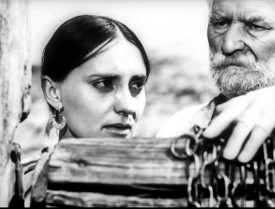
We have here the basic elements of the film: the old man, lonely, preparing for death; his missing sons and family; the well; the dry land; the village; the old woman/hag in black; the young woman; the film’s slow, languid rhythm; the recurrence of images, as of the young woman, hand held out, outside the window; the minimal soundtrack, with the occasional recurrence of the female voice singing (“Oi, hore, hore…“).
The land is Ukraine, dried up after years of drought, years underlined by war and by the break-up of the land-rooted family to the winds of modernity. The war is represented by the offical version of history–the statue of a Soviet soldier that is brought into the village, to the silent stares of the villagers–and by the very real death of the old man’s pilot-son, related in a striking sequence of images: a plane gliding overhead in stop-motion; a ram running into the stomach of the pregnant young woman three times; the old man sitting alone at the end of a long table, with a sudden gust of wind whipping up the tablecloth over his head and lifting away the empty chairs from around the table; a windmill turning; horses neighing fitfully; finally, the old man walking, as if mad or drunk–sideways–up from the bottom of the well.
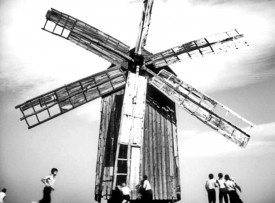
When the old man, earlier, had asked some soldiers if they had seen any of his sons, Illienko had given us an equally moving montage of soldiers marching off to war (upscreen), a few of them carrying children, who stare mutely into the camera, on their backs, intercut by shots of a turning windmill, the turning of a well-crank, an airplane being rolled out (upscreen), a soldier shot, bleeding.
The dispersed sons arrive with their families for what they think is the old man’s funeral; but he can’t seem to die. He has built a coffin for himself (out of the wood planks in which the statue of the soldier had been encased upon its arrival) and he sleeps in it. At one point, he takes to rowing with a pair of oars, imagining the water that is to take him away.
In a particularly telling scene, the entire family is searching the village graveyard for their mother’s/grandmother’s gravestone: they fail to find it, but the old woman in black watches them from a distance, and once they are gone she goes around collecting the wreaths they had left behind. (Who is the old hag, who curses and nags the old man, yet who knows what the others have forgotten? Where is their mother buried, or is she dead at all, perhaps she is the land, Ukraine, herself? Questions like these get evoked, but not answered.)

By the film’s end, the old man has closed up his well and is carrying an apple tree on his back, like a cross, into the dry desert. The pregnant young woman follows behind him at a distance, picking up the apples as they fall. The film ends as she clutches her belly, in pain. The ineffable look on her expectant face is, perhaps, a look of hope: life will continue, despite the surrounding barrenness.
Illienko seems to be implying that a fallow period may be coming to an end: the waters of life, it seems, need no longer be stored underground, but can be brought out to restore the once-fecund but for-so-long barren earth. The desert is the place where death resides (and where the old man goes to meet it) and where life emerges from once again. In the heady days of the mid-sixties it was, perhaps, appropriate to view the last thirty years as a desert wasteland, stretching back to the famine of 1932-33. Any new beginnings, Illienko seems to be saying, would have to be tentative and subtle–more like an apple-tree blooming in the desert than like a glorious revelation or revolution–and this new beginning (the film itself) had to wait 22 years before it made its way out into the world.
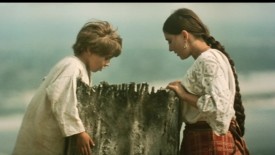
2. Eve of Ivan Kupalo (1968)
Eve of Ivan Kupalo (Vechir Na Ivana Kupala, 1968) takes on a wholly different method — maximalist where Well had been rather minimalist, it reflects the feverish vibrancy of the late sixties. Kupalo (also known as St. John’s Eve, the Christian name for the Midsummer’s night festival named for the Slavic pagan god, Kupalo) is an exuberant, phantasmagorical “trip” film, stylistically akin to the Latin American magic realist cinema or to the mystical psychedelia of Chilean-born Alejandro Jodorowsky.
J. Hoberman of The Village Voice called it “visual jazz,” a “peasant surrealism… at once folky and modernist,” and, he could have added, primitivist, slapstick and avant-garde all at once. Illienko pulls out all the stops, using solarization, herky-jerky rhythmic jump-cuts, synthetically-altered voices, people standing at odd angles and even defying gravity, cows painted yellow and blue (the colours of the banned Ukrainian national flag), gurgling angels and cackling witches, together with the Devil himself in fiery red Cossack garb.
The film, on the surface, is an adaptation of a densely-folkloric tale of the same name by Nicolai Gogol. A poor peasant’s son, Petro, enters into a pact with the devil, the demonic, brawling Basavryuk, to gain the riches he needs to win his lover, Pidorka, from her proud, wealthy father. The action unfolds from Petro’s trip into the underworld on Midsummer’s Eve through to Pidorka’s climactic trip to a grotto of the Mother of God where she gives birth to–an axe (!)–with which to cut the rope that binds her (and Petro) to the forces of Basavryuk. Illienko takes some liberties with Gogol, elaborating on his story to create an allegory of Ukraine’s colonization by foreign powers (and for this reason, we can assume, the censors could not possibly have passed it; according to Illienko, several minutes of footage toward the end was left out even in the version presently available).
Besides the folkloric and the allegorical, the film revels in a sometimes heavy-handed use of parody. The stylized, commercial excesses of state-sanctioned (and often popularly-supported) images of “Ukrainianism” crop up in exaggerated forms — Cossack-era romanticism, the pastoral Ukrainian peasant ideal, the notion that Ukrainians are a people always “singing and dancing and drinking.” The mouthpiece of this latter stereotype is the figure of the child empress Catherine (“But why aren’t they dancing?” she asks her aide, Potemkin, in a twisted, mock-French-aristocratic accent, “I know my people, they are always drinking and dancing”); and it is her empire (and its offspring) that is figuratively connected with perpetuating this image.
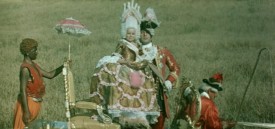
Throughout the film, Illienko has great fun playing with images–of supernatural beings and priests who turn into cuckoos and climb trees, of (literally) pig-headed rich peasants. But by the film’s cathartic end, it has become clear there is a more serious motive at work here.
The story takes the form of an underworld journey: there is an initiation (Petro’s, during Midsummer’s Night), a death (again, Petro’s), and a rebirth, that is at the same time a liberation. The Lord of the Underworld is Basavryuk, whose name closely resembles the Ukrainian word for “bastard” (baistryuk). Enlisting the aid of the “bastard force,” Petro marries Pidorka; but he remains haunted by his failed memory of what exactly happened on the fated Midsummer’s Night. When he suddenly remembers the sacrifice he had made (he was made to kill the image of Pidorka’s little brother, Ivas’), he disappears, leaving Pidorka behind with the task of completing the cycle. Bundling up the dead Petro’s ashes, she embarks with them on her own trip into the underworld (with balls of fire rolling down hills as they did during the Midsummer’s Night rituals when Petro went to seek Basavryuk). She carries the bundle through swampy steppes, and is pursued by Mongol horsemen in a comic sequence that mutates into a medieval Cossack-era pastiche, complete with bombastic symphonic music a la the “William Tell Overture.”
She finally arrives at the caves below Kiev, where hordes of deformed and disfigured bodies holding candles moan and beg for miracles, chanting “Shed a tear!” (“Prolyj sliozu!“) to the icon of Mary. The chant builds up to an eerie, deafening climax, until a voice is heard announcing the miracle, and Pidorka is back outdoors humming a lullabye to the axe she feeds at her breast, as a tear rolls down her face (suggesting her affinity with the Mother of God). This is intercut with images of her and Petro walking at the watery edge of the yellow steppe, bent over, pulling a rope seemingly attached to something that holds them back. Pidorka slowly takes out her axe and swings it into the rope, splicing into Basavryuk’s demonic laugh on the soundtrack. Liberated, they run free against the blue and yellow background, with the camera following them and speeding up (to the sound of bells) until the blue water (top half of the screen) and yellow earth (bottom, corresponding to the Ukrainian flag) fuse into a harmony.
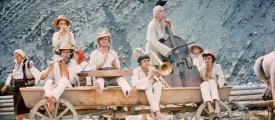
3. White Bird With a Black Mark (1971)
By 1972, Illienko had good reason to have lost any political optimism, and White Bird with a Black Mark (Bilyi Ptakh z Chornoyu Oznakoyu) seems to signify the turn to a resigned, if still life-affirming, recognition of the need to adapt. By this time, Illienko was in the position of having to prove his loyalty to the state, and numerous versions of White Bird were presented to the censors before it was finally passed, according to Illienko, by a stroke of luck.
The historically “sensitive” materials portrayed in the film (events in wartime Bukovyna in the Carpathian Mountains of western Ukraine) have been criticized by a few commentators for their “conformist” (pro-Soviet) interpretation. However — the facile banalities offered up by the writers of Soviet Film magazine notwithstanding — they are far from a historical propaganda job and are, in fact, fairly believable. The black-clad nationalist partisans could have been expected to be the somewhat rash, emotionally-driven fighters bent on remaining “masters in these mountains”; the Rumanian army did terrorize the peasant population; the Soviets did, initially at least, present the image of being brotherly liberators, and for all that the people in this removed corner of the Carpathians knew, they couldn’t be much worse than the previous occupiers, anyway. At times, Illienko seems to be slyly satirizing the “socialist realist” version of these events: the marching bands and fanfare greeting the Soviets’ arrival and the Soviet soldier-tractorist’s wedding with the lovely Dana are pervaded by a sotsrealist surreality.
A deeper reading of the film, at any rate, reveals a complexity and profound ambiguity. The film follows the activities of the Dzvonar family (dzvonar means “bell-ringer”), a family of village musicians. The father, out of desperation, decides he cannot feed his rather large family unless he sells his sons’ services. The village priest, whose daughter, Dana, is in love with each of the three eldest sons, Petro, Orest, and Bohdan, carefully decides to take the youngest, Georgyi, into his household. While the three oldest sons are off in the mountains, a Russian soldier decides to marry Dana, but the ceremony is broken up by the declaration of war.
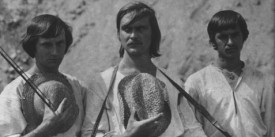
The family is broken apart: Petro goes to fight with the Soviets, Orest joins the nationalist partisans, while Bohdan hides from the war. Dana, in the meantime, has joined Orest in the mountains. Three years pass. When the Soviet soldiers return to the village, Dana’s Russian suitor is rejected by her and, eventually, suffers a colourful death at the hands of the partisans (he is tied to a tractor, which is then set on fire; Petro, trying to free him, dies as well). When a village celebration is disrupted by Orest’s return, he is blamed for the murder of his brother, chased down to the river and apparently shot. In the end, it is Georgyi, now a young doctor, who is left with Dana.
Illienko sets his characters out on the stage of twentieth century Ukraine. The old man, the “eternal musician,” is the keeper of time: he is constantly stumbling into the ticking alarm clocks he has set up for each of the nation’s different territorial occupants–some show Rumanian time, others Polish, German, Russian, and “our” time–”like my sons, each running to the wind, each on his own time.” The break-up of his family is the break-up of the country by war and foreign invasion from all sides. The village priest represents patriarchal Ukrainian tradition, pious but repressive towards his daughter Dana, who is the future, youthful, fertile, but uncertain. She is destined to marry one of the young Dzvonars–if not all three of them, their symbolic trinity broken up by the circumstances–if the nation’s life is to continue.
The film’s title refers to a story the young Georgiy is told by his mother:
“The stork was once a man. God gave him a heavy sack and said: ‘Take it away and throw it over a cliff. But don’t look at what is inside.’ But the man wanted to know what God knows and looked inside. It was full of snakes and vermin. The man threw it over the hill. But he had sinned. He had tried to learn God’s secret. And God said to him: ‘I shall turn you into a white bird with a black mark. When you rid the world of all foul things, I’ll turn you into a man again.’ Ever since, storks have been clearing from the world’s swamps and waste heaps the dark and evil things they let out of the sack.”
This universal theme of the war against the “dark” and “evil” things, the war to ensure purity, is ultimately what tears apart both the Dzvonar household and the whole country. The “black” is, in the end, projected onto the nationalist partisans (Orest becomes the scapegoat for his brother Petro’s death), just as each side had projected it onto its enemy.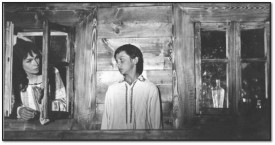
But Georgiy’s path toward knowledge is a different one: he seeks the “tree of knowledge, to be like God, to know good and evil,” he tells the village whore as she catches the boy eating apples from a tree outside her door. When she goes off with a foreign soldier, Georgiy tells her he could kill her. But later, older and wiser, he ceremoniously weds the rejected whore, just before she is killed by Rumanian soldiers. And it is he who ends up with Dana by the film’s end.
The final moments of the film preserve the ambiguity that is at its heart. When the flaming tractor, on which the rope-tied Russian soldier and Petro are riding, explodes and transforms into a tree of golden-red leaves, one could interpret this, in a more politically “conformist” fashion, as the tree of life growing out of the heroic self-sacrifice of the Soviet soldiers. Alternatively, one could say that life is being restored by the elimination of the tractorist and all that he represents. Either way, the foreign competitor for Dana’s love is gone.
After Orest is hunted down by the villagers (for his role in Petro’s murder, the murder that broke apart the “trinity” of brothers), a black horse (Orest’s unquiet soul?) runs around in a frenzy, against a snow-white background. Georgiy, now a young doctor, arrives to comfort him. Life begins to return to normal; but the priest (Dana’s father) is unable to adapt to the changed circumstances (he is seen madly beating a row of metallic hunks as if they were church-bells; later, he pulls out a gun on Georgiy, ordering him to confess his sins).
Georgiy, clearly, represents continuity: things go on, despite politics and wars and deaths, all of which balance each other out in the long run. Georgiy is dressed in white; he is a doctor. He has “made it” in the new Soviet society. Yet he clearly knows what he is doing. He adapts to the changes, in order to preserve the deeper, longer-term continuity (together with Dana). The priest cannot adapt; neither could Orest, and as a consequence they lose their minds or their lives in this new society.
And yet, the new world seems disturbingly unchanged, if not outrightly bleak. The barren whites that dominate the final scenes testify to this. The film’s closing image is of log rafts (on which the three brothers had travelled downstream) spiralling around aimlessly in the river–an ambiguous symbol that, positively, signifies that life goes on, continues, like the rotating tractor wheels and all of life’s rhythms; negatively, though, it implies that nothing really changes–the logs are not really going anywhere, but are caught in an neverending vortex.
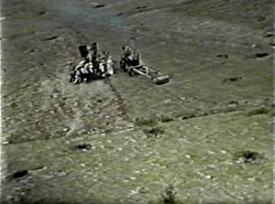
There is an image in the latter part of the film that carries a striking power: when Petro and the tractorist have returned to the village at the conclusion of the war, they take a tractor, in front of which is attached a long steel bar with a heavy roller that rolls over the land-mines left in the fields by the war, blasting them out of the reach of any villagers, and making the fields safe once again. A procession of villagers, led by the robed priest, cross in hand, are making their way, aimlessly it seems, across the countryside. For their own safety, they get in behind of the tractor, as it is the only thing they can do, offering as it does, safety, and they continue marching onward through the fields. This is, indeed, the only thing a nation of 50 million could do, in the face of the destruction of the war: take whatever security is offered, and continue living.
It had been Orest who loved his country (i.e. Dana) and his freedom so much, while Petro had placed a higher value on unity and on political progress (“Do you want us to go back to the way it was,” he had asked Orest in the forest, “with us being sold at the village market?”). In the end, they are both eliminated, their deaths balancing each other out; and it is Georgiy — who has come to know both the “black” and the “white,” the yin and the yang, who can flow with the outer, societal changes, preserving an inner freedom — who succeeds in maintaining the family and preserving the circular movement of life.
In a similar way, it is Illienko — whose films exude the powerfully pagan spirit of Ukrainian folklore and legend, and yet, who understands the complexities of Ukraine’s social struggles of the past and present — it is he who, among the filmmakers of the Poetic Cinema, maintains the deepest link with the well of his people’s spiritual memory.
The first step a colonizing power undertakes against its conquered subjects is usually the attempt to uproot them from their collective identity. Illienko, master filmmaker that he is, has kept that identity alive and kicking. And in this remarkable trilogy of films he follows a movement that leads from a cautious, lyrical poem of survival, to a paean of liberation, and finally, most realistically perhaps, to an acknowledgement of the need for creative adaptation.
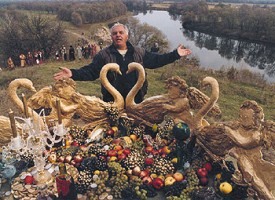
[1] “Poetic cinema” is the name given by critics to a movement that emerged in the 1960s at the Dovzhenko Studios in Kyiv (Kiev). The label is less than satisfactory, as two of its practitioners, Yurii Illienko and Sergei Paradzhanov, have said that there is only “cinema” and “commercial cinema” — theirs, of course, being the former. The distinctive features of the school include an emphasis on folklore, legend, nature, allegory — which in many cases presents a rather exotic texture to foreign viewers — and an elevation of the visual, painterly, and formal elements of the film, dominated in the case of Paradzhanov by symmetrical, frontal, almost static frames, and in the case of Illienko by surreal imagery and wildly swirling camera movements. Other Ukrainian filmmakers working in the genre included Leonid Osyka, Volodymyr Denysenko, Mykola Mashchenko, and Ivan Mykolaichuk.
Put into historical perspective, the movement harkens back to the lyrical, poetic films of the early master Alexander Dovzhenko, and it extends outwardly (through mutual influence) to the work of other Soviet filmmakers, such as Georgian-born Tenghis Abuladze (whose The Plea was shot by Illienko’s assistant, Aleksander Antypenko, and whose Repentance garnered international praises two years ago), Russian-born Andrei Tarkovsky, and the latter’s “students”, among them Konstantyn Lopukhans’kyi (Letters from a Dead Man) and Aleksandr Sokhurov (A Lonely Human Voice, Days of Eclipse).
[2] A bit of historical background may be helpful here. Ukrainian historians trace their past back to the Kievan Rus’ empire, which had reached its (glorious, by state-ist standards) peak in the 10th and 11th centuries. It is this state that Ukrainians claim the later Muscovite Russians appropriated into their own history. (Soviet historians consider Kievan Rus’ to be at the root of the three “brotherly” eastern Slavic peoples: the Ukrainians, Byelorussians, and Russians. Historical evidence, for the most part, seems to indicate that the Muscovite state emerged independently from the Kievan, whose ancestors consisted of a mixture of the Polyanian and other south-eastern Slavic tribes, and at least a touch of Scandinavian, in the case of the ruling caste. The Ukrainian language has developed on its own for the last several centuries, from original Slavic roots.)Put into historical perspective, the movement harkens back to the lyrical, poetic films of the early master Alexander Dovzhenko, and it extends outwardly (through mutual influence) to the work of other Soviet filmmakers, such as Georgian-born Tenghis Abuladze (whose The Plea was shot by Illienko’s assistant, Aleksander Antypenko, and whose Repentance garnered international praises two years ago), Russian-born Andrei Tarkovsky, and the latter’s “students”, among them Konstantyn Lopukhans’kyi (Letters from a Dead Man) and Aleksandr Sokhurov (A Lonely Human Voice, Days of Eclipse).
In any case, the Ukrainians, living in the steppe, woodland and forest regions around the medieval Kievan Rus’ lands north of the Black Sea, had been under various degrees of foreign occupation (mainly by Muscovite Russians, Poles and Austro-Hungarians) since the free Cossack state of the 17th century. In the period of the First World War, a broadly-supported independent Ukrainian (autonomous democratic socialist) government emerged in Kiev for a short period; short-lived independence was later achieved in some of the Western Ukrainian lands as well. Eastern Ukraine fell under Soviet Bolshevik rule following the war, though the twenties saw the emergence of a widespread cultural ferment, later to be stifled by Stalin.
Western Ukrainian lands have variously spent the twentieth century under occupation by Poles, Germans, Soviets, and in places, Austrians, Hungarians and Rumanians. Some of the worst excesses of the interwar and Second World War periods occurred on Ukrainian lands, among them Stalin’s artificially-induced famine and imposed state collectivization of lands, and the usual butcheries of war. National sentiments have continually re-emerged under foreign occupations, most recently, and quite cautiously, under “glasnost.” (A recommendable treatment of these themes, including a fair account of the respective claims to Kievan Rus’, is found in Orest Subtelny’s Ukraine: A History, University of Toronto Press, 1988; see particularly, pp. 52-54.) - Immanence
Shadows of Forgotten Ancestors (1964)
Film director Yuri Ilyenko, one of the outstanding cinematographers and directors of the short-lived but significant Ukrainian New Wave, has passed away at age 74. Ilyenko (aka Illienko, Ilienko) first shot into prominence as the cinematographer on Sergei Paradjanov’s epochal Shadows of Forgotten Ancestors (1964), which launched what became known as “Ukrainian Poetic Cinema,” a movement based mainly at Dovzhenko Film Studios in Kyiv. In the years following, Ilyenko directed a series of critically lauded films including “A Well-Spring for the Thirsty” (Krynytsia dlia sprahlykh), considered a sobering, post-Holodomor updating of Aleksander Dovzhenko’s classic “Earth” (Zemlya), the wildly experimental “Eve of Ivan Kupalo” (Vechir na Ivana Kupala), “White Bird with a Black Mark” (Bilyi ptakh iz chornoyu oznakoyu), “A Forest Song (Lisova pisnia: Mavka“), and “Swan Lake: The Zone” (Lebedyne ozero: Zona).
Made in 1966, “Well-Spring” was shelved by Soviet censors for over two decades until it was officially released during the Glasnost era in 1988. “Eve of Ivan Kupalo” (1968) was rarely screened in the Soviet Union as well, but with “White Bird with a Black Mark” (1971) Ilyenko carved out a viable compromise between artistic integrity and a storyline that satisfied the Soviet censors. The film was awarded the Grand Prize at the Moscow International Film Festival. Ilyenko’s efforts in recent years, especially the controversial “A Prayer for Hetman Mazepa” (2001), met with more mixed reviews.
Ilyenko was a genuine magician behind the camera, the kind of person with so much energy, pent up over many years of difficult production circumstances, it’s a wonder he survived to make films after the Soviet Union fell. “Shadows” is completely different in style from Paradjanov‘s other films — note how wildly that camera moves in the woods (attributable more to Illienko than Paradjanov, though the latter’s experimental spirit deserves the credit for the film as a whole, which is arguably one of the most significant in Soviet cinema history).
I once wrote an essay analyzing Ilyenko’s “trilogy” (Well-Spring, Eve of Ivan Kupalo, and White Bird), in the era before publications went electronic. I’ll try to dig it up. He’s not nearly as well known as he should be, so I’ll share another couple of clips here, from Eve of Ivan Kupalo and Swan Lake: The Zone:
Ukrainian Poetic Cinema at the Lincoln Center
The Film Society of the Lincoln Center is showing the cream of the crop of Ukrainian cinema on September 7-12 in a series entitled “Capturing the Marvelous: Ukrainian Poetic Cinema.” All of these films are nothing short of dazzling and some of them are not readily accessible on DVD with English subtitles, so if you live in New York you would be crazy not to catch them on the big screen. I write about most of these films in my forthcoming book on Sergei Parajanov, so they are still very much fresh in mind.Broadly speaking, Ukrainian poetic cinema tends to focus on Ukrainian identity and culture (especially folklore), employs a painterly visual style and pushes the boundaries of film technique and narrative. The term “poetic” comes primarily from the films’ abundance of metaphors and symbols, but one can further extend the parallel with poetry as a literary genre and how many of the films use the language of cinema.
Generally, critics trace the origin of Ukrainian poetic cinema to the films of Alexander Dovzhenko. His silent films Zvenigora / Zvenyhora (1927) and Earth (1930) are readily available on video and are widely written about, so I do not need to belabor their virtues here. If there is an omission in the series, it is Dovzhenko’s first sound film, Ivan (1932), whose experiments in editing and sound likely influenced Ukrainian poetic filmmakers in the 1960s.
Sergei Parajanov’s Shadows of Forgotten Ancestors (1964) was his first international success and his masterpiece alongside the Armenian production The Color of Pomegranates (1969). Easily the most widely seen and discussed Ukrainian film after Dovzhenko’s Earth, it initiated the Ukrainian poetic cinema revival of the 1960s, which was based out of the Dovzhenko Film Studio in Kyiv. As with Shadows, the majority of these Sixties films were set in the past or in rural locales, a trope which the filmmakers used to explore questions of Ukrainian history and identity.
Yuri Illienko (1936-2010), the director of photography for Shadows, subsequently became a major director in his own right. His brilliant debut, A Well for the Thirsty (1965, also translated as A Spring for the Thirsty), based on a poetic script by Ivan Drach, was surely one of the most daring formal experiments ever produced in Soviet cinema. Virtually plotless and lacking dialogue for large portions of its running time, the film concerns an old man who lives alone since his wife has passed away and his sons have departed. The village where he lives is surrounded by parched soil, but the water from his well sustains the villagers and, years earlier, soldiers who passed through during the war. The man envisions a beautiful young woman, presumably his wife at a younger age, carrying pails of water. The densely textured film uses repeated visual and audio motifs to create a structure akin to a musical composition. Continuing the experiments with film stock that Illienko began while working on Shadows of Forgotten Ancestors, the film uses special high-contrast stock, at times pushed even further so that the stark black-and-white imagery looks like an engraving or ink drawing. The sound track is a complex audio collage of recited poetry, song fragments, cries and sound effects such as ringing bells; no doubt it served as a major source of inspiration for Parajanov’s use of sound in The Color of Pomegranates. The film ran afoul of the authorities and was banned until 1987, when it was finally released along with a number of other long-banned Soviet films.
Illienko’s second feature, The Eve of Saint John (1968) is an ambitious adaptation of Gogol’s story of the same name. (Arguably, a better translation would be The Eve of Ivan Kupala, since it refers to the summer festival that originated as a pagan fertility rite.) The film’s style and imagery attempt to recreate the phantasmagorical world of Gogol’s prose in cinematic terms through jump cuts and other forms of trick editing, exaggerated Ukrainian decorative motifs, and distortions of scale and perspective. Beyond that, Illienko tries to make the film into a meditation on Ukrainian history; at one point, the main character of Pidorka (Larisa Kadochnikova) is caught up in the Mongol invasion of the thirteenth century and subsequently witnesses Catherine the Great and Potemkin’s legendary tour of facade-villages in the Ukrainian countryside. Ultimately, the film seems overburdened with trick effects and was coolly received by Soviet critics, but it remains memorable for its extraordinary wealth of surrealistic imagery. It is an absolute must on the big screen.
Illienko’s greatest commercial and critical success was by far White Bird with a Black Mark (1970), which won the Golden Prize at the Moscow Film Festival in 1971 and drew 10.5 million admissions in the Soviet Union as a whole. Co-written by Illienko and its star Ivan Mykolaichuk (the star of Shadows of Forgotten Ancestors), the film concerns an impoverished Hutsul family whose loyalties are divided between the Soviets and the Romanians during World War II. It deploys a straightforward narrative and pointedly orthodox representations of negative figures such as the band of Ukrainian nationalist insurgents and the priest. But it also contains many of Illienko’s characteristic stylistic touches, including jump cuts, 360-degree tracking shots, and telephoto camerawork that strongly recalls Shadows of Forgotten Ancestors.
Leonid Osyka (1940-2001) may not be as well known in the West as Parajanov or Illienko, but The Stone Cross (1968) stands alongside their works on its own terms. Based on a script by Ivan Drach and adapted from the writings of Vasyl Stefanyk, it depicts an old man in Western Ukraine who tires of working his barren plot of land and decides to emigrate with his family to Canada. On the eve of his departure, he catches a thief on his farm and plans to kill him, but succumbs to compassion while his neighbors stand fast in their rigid code of honor. As a memorial to his life in his homeland, he leaves a stone cross on a hill. Especially noteworthy is the farewell party, which takes up about half of the 80-minute film. In a series of long takes, the camera circles around the villagers, following the old man while he approaches various individuals, speaks, and offers to drink toasts with them. The overall texture of the film is deliberately spare compared to the kaleidoscopic quality of Shadows of Forgotten Ancestors or The Eve of Ivan Kupala, and it depends more heavily on dramatic dialogue than A Well for the Thirsty. Still, a great deal of the film’s sense is conveyed through its expressive imagery, including intense close-ups of the villagers’ time-ravaged faces and the heavily flattened, almost abstract images of the countryside.
The Ukrainian poetic cinema revival continued through the early 1970s, though some of the films were banned or shelved, and others received only limited distribution outside of Ukraine. In May 1974, less than a month after Sergei Parajanov’s imprisonment on politically motivated charges of homosexuality, Volodymyr Shcherbytsky, the First Secretary of the Communist Party of Ukraine, publicly condemned Ukrainian poetic cinema and declared it “overcome.” Despite this, Yuri Illienko continued to make innovative works, though his first three films remained his strongest. Leonid Osyka’s subsequent output was more uneven. Still, the films shown in this series represent a major contribution to world cinema and the best postwar Ukrainian films alongside those of the Odessa-based Kira Muratova.
Symbol Life [SWAN LAKE — THE ZONE]
From the Chicago Reader (June 14, 1991). — J.R.SWAN LAKE — THE ZONE
*** (A must-see)
Directed by Yuri Illienko
Written by Sergei Paradjanov and Illienko
With Victor Solovyov, Liudmyla Yefymenko, Maya Bulhakova, Pylyp Illienko, and Victor Demertash.
One of the most fascinating things about Russian cinema is that we still know next to nothing about it. There are the socialist realist holdovers (Little Vera, for example, and Freeze — Die — Come to Life) and wannabe American releases (Taxi Blues), but the rest of the recent Soviet pictures that have made it to Chicago are interesting mostly because of what remains obscure and intractable about them — their refreshingly and, at times, bewilderingly different views of life and art.
The films that constitute the most obvious reference points in Soviet film history — a few key classics by Eisenstein, Pudovkin, Dovzhenko, Kuleshov, Vertov, and closer to the present, the films of Paradjanov and Tarkovsky — have practically nothing to do with what ordinary Soviet moviegoers see most of the time. Even worse, we can’t take it for granted that these avant-garde works necessarily represent the best that innovative Soviet cinema has to offer, or that what we see of the Soviet mainstream is necessarily the best either.
If I hadn’t lived in Europe for several years, I would never have seen about a third of the best Soviet films I know: the first sound films of Kuleshov (The Great Consoler, about the life and stories of O. Henry), Pudovkin (Deserter), and Dovzhenko (Ivan) and Julia Solntseva’s rather insane 70-millimeter Stalinist spectaculars, especially The Enchanted Desna. None of them has ever been subtitled in English, and few are currently very well known in the Soviet Union either. [2011 postscript: today, at least the first two of these films are commercially available on DVD with English subtitles.]

Early last month I attended two lectures at the University of Chicago by Yuri Tsivian, a Soviet film historian from Latvia, about prerevolutionary Russian cinema — one about censorship codes in that period, illustrated by several video clips, and a more general lecture followed by three films made in 1913 and 1914. (A touring show devoted to Russian cinema before the revolution is in the works and will eventually play at the Film Center.) What’s most amazing about these movies — dismissed by many modern Soviet filmmakers as bourgeois, decadent, and even “necrophiliac” — is their radical differences from such contemporaneous American movies as The Birth of a Nation: above all, their pronounced feminism and their visual sophistication, especially the varied camera angles, deep focus, and camera movements.

The value of these early films — including Merchant Bashkirov’s Daughter and the 1914 The Woman of Tomorrow, about a woman gynecologist at a time when there were already hundreds of them in Russia — is how much they have to tell us about an unfamiliar world and culture. The masterpieces cited above (from the 30s, 50s, 60s, and in the case of Muratova’s film, 1989) tell us things not only about history but about the present, and not only about Soviets but about ourselves.
Especially exciting in the post-50s work is a combination of realistic and nonrealistic modes, which might be called allegorical realism. This form of cinema seems to take place inside the mind rather than in the world, yet it’s full of realistic details in the settings as well as in its tactile sensations. Paradoxically, these conceptually abstract films are unusually concrete, immediate and richly textured physically, handling such elements as moving water with a sensuality missing from American and European movies.
Yuri Illienko’s Swan Lake — The Zone is no masterpiece, but it’s a lot more interesting than most American or European movies I’ve seen this year, and it has an enormous amount to teach us. Historically, it qualifies as the first truly independent Ukrainian feature: it was financed as an international coproduction with Sweden and Canada and coproduced by Illienko and Las Vegas symphony conductor (and fellow Ukrainian) Virko Baley. Its source is a series of stories composed (not written) by the great Armenian/Georgian filmmaker Sergei Paradjanov during his many years in prison. As Illienko explained to me at the Vancouver film festival last fall (mainly through a Ukrainian interpreter), Paradjanov was often denied writing materials in prison, so he learned to memorize the stories he made up. Illienko got him to recite them into a tape recorder, and wrote the script based on those recordings. Paradjanov was dying of cancer while the film was being made, but Illienko was able to show him the finished work before he died; the director even included one detail — a French magazine with a photo of Paradjanov and the caption “Maestro” — mainly for the pleasure he knew it would give Paradjanov.
What emerges from this unusual collaboration is not an “homage” to Paradjanov, at least not in the usual sense of that word. The visual and aural styles of the film have no apparent relationship to Paradjanov’s filmmaking, and the content is equally remote from Paradjanov films (at least those known in the West, all of which are set before the 20th century).
What has all of this to do with Swan Lake — The Zone? For one thing, the prison where the film was shot is the same prison in which Paradjanov was incarcerated; most of the prisoners we see are real-life prisoners there today, so the film offers a horrifyingly lucid portrait of what Paradjanov’s life there must have been like, and what it continues to be like for more recent arrivals. (The very fact that this can be done in a contemporary Soviet film is noteworthy in itself; it’s difficult to imagine many — or any — American films about prison life adopting the same degree of candor.)
In most other respects, Swan Lake is a far cry from a documentary. Working almost completely without dialogue (so that subtitles are sparse) and with nameless characters, the film is usually easy enough to follow, though curiously some of the details mentioned in the press synopsis are not evident on-screen. To clarify this difference, I’ve included some of the information from the “official” synopsis in brackets.
At the beginning, the hero (Victor Solovyov) breaks out of the prison [three days before his sentence is over] and hides out in a huge, metallic hammer-and-sickle monument that stands at the prison gates. (Illienko told me that prison monuments of just this type are quite common in Russia, so the allegorical implications stem directly from social reality. Given all the symbolic and tactile ramifications of this claustrophobic location in the film, it functions not as a dry or pretentious symbol but as a “lived-in” allegory as well as a lived-in site.) On sorties from his hiding place, the man steals clothes from the trunk of a car and later tries to hitch a ride, only to be beaten by a carload of thugs; in his hideaway, drinking from bottles of champagne, he gets drenched in a rainstorm.
A woman (Liudmyla Yefymenko, Illienko’s wife) who lives nearby discovers his hideout, nurses him back to health, and becomes his lover. We also see her purchasing a train ticket, perhaps with the idea of escaping with him. Her son (Pylyp Illienko, the director’s son), who generally uses the monument as his own hideaway (where he leafs through the aforementioned French film magazine), expresses his disapproval of the couple by firing rocks against the monument with a slingshot when they’re inside [and by reporting the man’s whereabouts to the authorities].
Back in prison, the man attempts suicide and is pronounced dead and carried off to a morgue in a horse-drawn carriage. When he’s found to be still alive, the driver revives him by giving him blood for a transfusion, administered by an old woman. The man returns to the prison voluntarily, but is treated roughly by both the authorities and the other prisoners, who tell him he must spit in the face of the guard who saved him and then abide by the punishment for this action: another five years in prison. He slits his wrists, and the next morning his dead body is stared at by the other prisoners and ignored — or not noticed — by the guards.
The film’s title refers to the swans in the wasteland surrounding the prison. In an early sequence they’re briefly and improbably glimpsed inside the prison, when we see the clamoring prisoners getting hosed down by the guards. There’s also a very strange animated sequence, which may be taking place inside the hero’s head when he’s hiding inside the monument, that shows blue swans against a blue background flapping their wings.
I suppose these swans are allegorical to the same degree the monument is — or the map of the world on which the hero is laid in the morgue, the map covering a board placed over a bathtub containing another corpse. But the poetic meanings of the swans, as of the other details, are clearly meant to be experienced rather than rationally decoded. The worst, most demeaning approach to a movie like Swan Lake — The Zone would be to reduce it to a “purely” political allegory. True, Soviet directors tend to be more directly political than their American and European counterparts — Illienko expressed only contempt for Julia Solntseva’s films because of their Stalinist underpinnings, and Paradjanov, despite his own martyrdom, criticized Tarkovsky after glasnost for making his last films abroad. It’s also true that Soviet directors don’t usually display our bad habit of considering their ideology and their aesthetics as separate and unconnected entities. More holistic about the spiritual breath of reality, these filmmakers bring a vitality to allegory by treating it as an adjunct to lived experience rather than as an alternative to it.
An important part of the “realism” that plays against the “abstraction” of Swan Lake — The Zone is the film’s highly inventive sound track. This kind of realism, however, usually gives a particular inflection to the images rather than reproducing or reinforcing them in the conventional manner. When the film opens with the hero fleeing in long shot through a wasteland, what we hear is the sound of his labored breathing. Similar aural close-ups are later accorded to the clinking of bottles inside the monument, the tinkle of the woman’s hammer-and-sickle earrings, and many other small, odd sounds. The effect is always to intensify the physicality of the object that is aurally highlighted. (Tarkovsky and other Soviet contemporaries have used sound similarly, but the only American or European parallel that comes immediately to mind is Jacques Tati, who also avoids expository dialogue. Is it only coincidence that Tati’s family background was Russian, his original name Tatischeff?)
Conventional verisimilitude is not to be expected in a film of this kind. The hero’s proximity (and later the heroine’s) while inside the monument to prison guards and activities, which the sound track emphasizes, makes it implausible that he could remain undiscovered. It’s almost equally implausible that at the end the guards, playing what looks like dominoes, would fail to notice his “crucified” body a few yards away. Both cases recall Edgar Allan Poe’s “The Purloined Letter,” where the centrality of the hidden object is an essential part of its invisibility; it’s worth stressing that throughout most of the film the hero exists as an object rather than a character.
It could be argued that allegory and symbolism in contemporary Soviet films are legacies of the repressive past, when meanings often had to be cloaked in ambiguity in order to get by the censors. If there’s any truth to that hypothesis, I don’t think it means Soviet cinema today is any less “free” than our own; if anything, it may suggest the contrary because of the expressive registers developed as a consequence of repression.
Much as the elaborate constraints of Hollywood under the studio system gave a stylistic coherence to many movies that’s hard to find today, comparable constraints may have provided the impetus for the “allegorical realism” of contemporary Soviet cinema. We’re often quick to condemn the former restrictions of Soviet cinema and exalt the former constraints of Hollywood, but the fact remains that Orson Welles had as hard a time as Sergei Eisenstein did. And now that a good many Soviet filmmakers seem to be freer than most of their American and European counterparts, it’s about time the rest of world cinema heeded the many formal, stylistic, and expressive alternatives they have to offer.
- Jonathan Rosenbaum
Filmed in 1965 and just as contemporary now as it was then, Yuri Ilyenko's directorial debut, A SPRING FOR THE THIRSTY, is a surreal cinematic poem from the cinematographer of Sergei Paradzhanov's 1964 SHADOWS OF FORGOTTEN ANCESTORS. (Ilyenko's best-known film, BIELAYA PTITSA S TCHORNEM PIATNOM [The White Bird Marked with Black] was made five years later and was named best film at the Moscow Film Festival.) As director-cinematographer of A SPRING FOR THE THIRSTY, Ilyenko has created a parable centering on an old man who lives a secluded life in the desert, alone with only his memories and photographs. His wellspring, once a source of joy and hope for thirsty passersby, is now rarely used. No longer able to find comfort in his memories, he turns all his photographs to face the walls. Divided into five sections--"A Coffin Is Needed," "Long July Nights," "The Day of Judgement Arrived," "The Son," and "Epilogue"--A SPRING FOR THE THIRSTY is practically a silent film. From its powerful, abstract black-and-white images, however, we learn that the old man is waiting to die. He builds himself a coffin, then sleeps in it, hoping to facilitate the last rite of passage. While he waits he is harassed by an elderly townswoman who helps him dig his grave. Distressed that he has lost the desire to live, she shouts, "Why do you need a coffin, you Antichrist?" He ignores her and reflects on all the people he has met at his well: two young brides who drink from the bucket as he holds it; a young child and his father; a beautiful young woman who beckons him and exclaims, as she washes her face, "Water, you are so lovely"; a young soldier unexpectedly shot by an unseen enemy (the bullet piercing the bucket as he drinks) in whose honor the town erects a statue, the old women and children crying in striking close-ups as the monument is lifted from its crate. As stunning as his compositions is Ilyenko's inventive and minimal use of sound. A series of still photos of the old man chopping down a tree is intercut with scenes of children playing on a windmill, with the sounds of falling trees and laughing children juxtaposed. Suddenly a guitar is heard, and the old man's family arrives for a visit. His young, pregnant daughter-in-law has brought him a tape recorder and tries to get him to speak into it, but he starts to laugh uncontrollably. Although his son and family have also returned home for the visit, it is only the daughter-in-law who understands him. As he walks across the desert carrying a fruit tree, she is the only one to follow, picking up the fruit that falls from the branches. After picking up several pieces she is stricken with pain, drops the fruit, falls to the ground, puts her hand to her abdomen, and smiles as the film ends.
A SPRING FOR THE THIRSTY is an abstract visual work and not for the casual moviegoer, but its rewards are great for those who appreciate the sublime power of simplicity. It is a simple parable about the absoluteness of human thirst. Ilyenko's images are also simple, and their power may be lost on contemporary audiences used to high-tech special effects. The purity in his close-ups of the old man, the dying soldier, the thirsty young brides, and the village children are what make A SPRING FOR THE THIRSTY a masterful work--one worthy of comparison with another Ukrainian master, Alexander Dovzhenko. Ilyenko collaborated with the poet Ivan Dratch to create this lyrical work, which expresses the desires and fears of not just one man, but of a people who find temporary solace at his well and who continue, ultimately, to search for spiritual happiness whether it be found in this life or some other. In this cinematic poem Ilyenko has brilliantly realized the credo upon which Dovzhenko based much of his own work: "Let us not treat the theme of ordinary man as an ordinary theme. A film that is not steeped in human feeling is like a planet without atmosphere." - movies.tvguide.com
HARVARD STAGES U.S. PREMIERE OF FILM “A PRAYER FOR HETMAN MAZEPA”

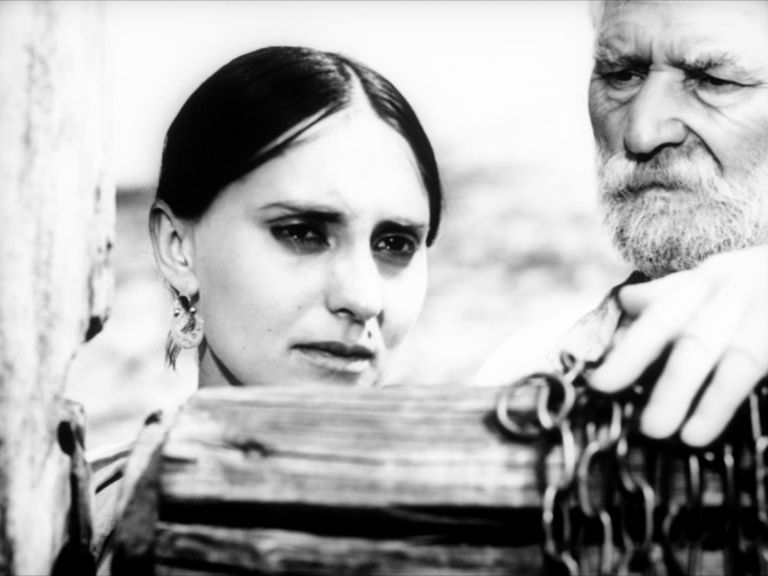

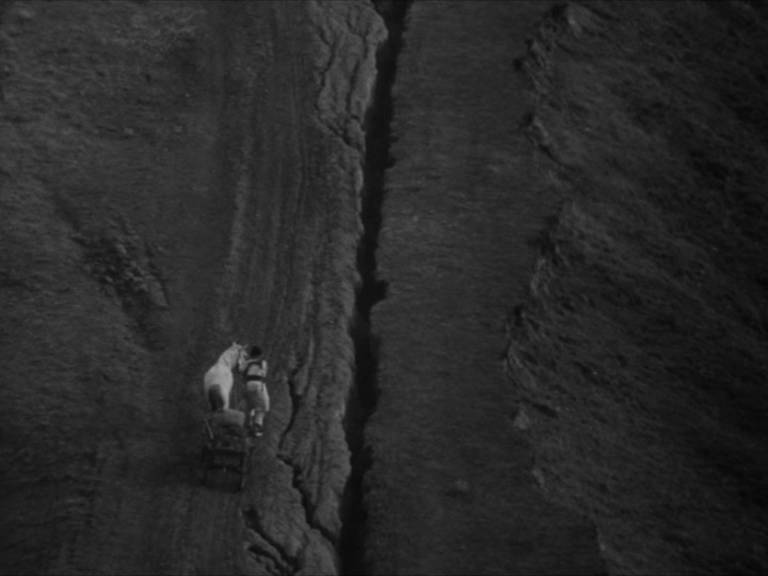









Nema komentara:
Objavi komentar